Hector Hugh Munro - known as "Saki"
(1870-1916)
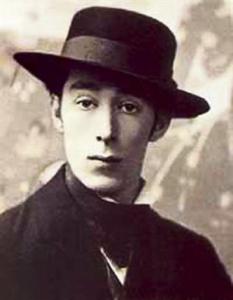
| Home |
Endorsements |
About the
Exhibition |
Benjamin Manning |
Colonel and Sarah Hibbert |
F R Lee |
Henry Williamson |
Timeline |
Hector Hugh Munro - known as "Saki"(1870-1916) |
What is Saki's connection with Manning's Pit?
Manning's Pit in May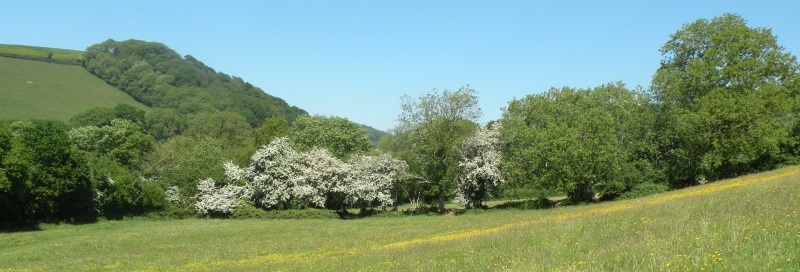
|
|
|
|
| Local legend
has it that Hector's mother was knocked over by a
runaway cow in one of Pilton's narrow lanes, while
pregnant and expecting her fourth child, and she then
died following a miscarriage. On the right: North Devon Journal, 7 March 1872 - thanks to Bill Greenwell for this cutting. |
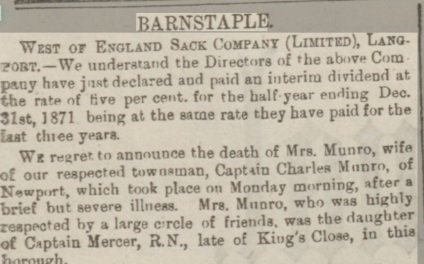 |
Saki's love of the countrysideIt is sometimes assumed - based mainly on his sister Ethel's recollections - that Hector saw little of the countryside as he grew up, because of restrictions put in place on the children's activities by the Aunts. Ethel destroyed most of Hector's papers after his death, so the main evidence about his childhood comes from her short biography in the book "The Square Egg.""Then we should have had more country walks than we ever got," she wrote in that book, "there were lovely fields and woods quite handy, but Aunt Augusta wanted shops and gossip - also she was afraid of cows." If the story about their mother being knocked over by a cow is true, then it is not surprising that Aunt Augusta was afraid of cows. Nonetheless, Ethel didn't say they never had walks. She also had this to say about the governess they had when Hector was twelve: "She was, however a real companion, and took us for walks in the countryside we loved and explored the whole countryside." Their father did the same when he came back from India once every four years. Their Uncle Wellesley, who visited annually, took Hector on fishing and sketching expeditions - where better to stand with your fishing rod than the Manning's Pit bridge? It is also true that when Hector was older, and came back on holiday from boarding school, he had more freedom to roam the countryside. So did the "lovely fields and woods quite handy" and the "countryside we loved" include what we now know as Manning's Pit? It must surely be so. The attractions of the river, and the bridge, and the pools of water where fish can be found, kingfishers dart across the water and otters lurk in hiding, must have been as alluring to the Munro children as they are to children today. And we have little doubt that when it snowed the steep slopes of the field (described by a local as "Pilton's Cresta Run") would have been where local children took their sledges - or make-do equivalents - as they do today. One final piece of evidence comes from Hector's friend, Rothay Reynolds, who wrote about him after his death. He said, about Hector's childhood, that "He loved above all, the woodlands and the wild things in them, especially the birds." Old maps of the Manning's Pit area show wooded areas similar to those today that edge the river in many places. Present day people often talk of "the woods by the river, or the woods by the rope swing," for example, and they are still home to wild things, as they were in Saki's time. Incidentally, a tale we were told about a snowfall in the 1960s (or around that time) would surely have amused Saki. The vicar at the time didn't have a sledge but was so desperate to join in the fun in Manning's Pit, that he was seen sledging down the slope astride an old framed oil painting! The Munro's Social Life, and their Famous Neighbours, Colonel Hugh Hibbert and Frederick Richard Lee, R.A. |
More from "The Square
Egg."
|
|
The walk
from Pilton Church back to Broadgate Villa,
photographed today.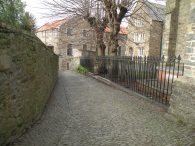 Coming out of Pilton Church, the Munro - and Hibbert -families would have walked through the churchyard here, down some steps before turning shortly afterwards and possibly walking up Church Lane (below) 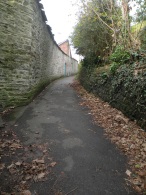 From the top of Church Lane, they would have walked along Bellaire, to Broadgate house (below, the end of the house) home of the Hibberts and F R Lee. 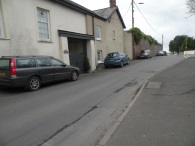 The Munro's house was just across the road. ( the yellowish wall you can just glimpse across the road is the present day wall of what was once Broadgate Villa) |
Ethel describes Pilton
as a sort of Cranford: saying "there were about
ten families, most of them without children, so we
got to know grown-ups well and to be quite at ease
in their society".
The grown ups who lived closest to the Munros were F R Lee, R.A., the famous artist, his daughter Sarah Catherine, and her husband, the gallant war hero, Colonel Hugh Hibbert. They lived in Broadgate House, directly across the road from Broadgate Villa, and were the owners of the grand Broadgate Estate. Lee was not only famous but very wealthy, as descriptions of his wonderful yacht Linda, in which he sailed to Australia and back, attest. He appears to have been generous as well . We have no direct evidence as yet to prove that the two families were on friendly terms, but Henry Williamson's son and daughter in law believe that they were. One of the children who lived across the road from the Munros and saw them in Church each Sunday was Margaret Dora Hibbert, whose daughter Ida Loetitia married Henry Williamson. You can read more about this connection on the page about the Hibberts, and the Henry Williamson page.. The older Munro Aunt was named Charlotte, but she was always called "Tom," and Ethel wrote that she took the children to Pilton Church regularly. Benjamin Manning and his family were closely involved with Pilton Church, and so were the Hibbert family, so presumably there were many occasions when all the three families featured in our Museum Exhibition were present at the same time. Ethel wrote this
about Aunt Tom:
"For a long time I was struck by her familiarity with the Psalms, which she apparently repeated without looking at her book, but one day I discovered she was merely murmuring, without saying a word at all, and had put on her long distance glasses in order to take good stock of the congregation and its clothes. A walk back after church with various neighbours provided material for a dramatic account to Granny (not that she was interested) of the doings of the neighbourhood." Anyone who does that walk today (see our photographs on the left, or look at the map, shown earlier) can easily imagine the Munro Aunts and children passing the time in conversation with Sarah and Colonel Hibbert and their children, as they came out of the church and navigated the cobbled churchyard path and steps down to Church Lane. The two families certainly had a great deal in common, and plenty to talk about: Col. Hibbert had served in India, Captain (later Colonel) Munro was in the Indian Imperial Police. Hector's mother's family were in Kent, and Sarah Hibbert and her father had lived in Kent. |
The Young Saki's inspirational Neighbour:Colonel Hugh Hibbert - the Crimean War HeroColonel Hibbert, who had lived in Cheshire before his marriage to Sarah Lee, had come back from the Crimean War as a war hero. He had fought with great bravery, and the town of Macclesfield declared a public holiday on the day that they presented him with a beautiful sword. It was paid for with donations from local people, and decorated with gold leaf and even tiny diamonds in the eys of a lion. You can read the fascinating story of this presentation and Hugh Hibbert's war time exploits at this link to an article in the Macclesfield Express, the war-time part of which is based on research by local historian Dorothy Bentley-Smith. The young Saki could hardly have had a more inspiring neighbour.Years later, in 1915 Hector wrote this, about war: "Nearly every red-blooded human boy has had war, in some shape or form, for his first love...." and "...There are other unforgettable memories for those who had brothers to play with and fight with, of seiges and ambushes and pitched encounters, of the slaying of an entire garrison without quarter, or of chivalrous punctilious courtesy to a defeated enemy." As Hector and his brothers played at war, in the Broadgate Villa garden behind its stone walls, it is hard to imagine that they did not think of - or even model themselves on - the Colonel across the road? As we said earlier, it seems that little has been written before about Saki's connection to the Hibberts and Lee. It is only because of our focus on Manning's Pit, the location as a whole, and the people who live near the fields, that we have learned about the Colonel ourselves. One thing we can't help wondering about, especially, is whether Colonel Hibbert ever showed Hector, and his siblings, his beautiful presentation sword? A final point in common the two families had was that both families were very interested in politics, and were strongly Conservative. Hector was from an early age a keen Conservative, which could have given him more reason to admire Col Hibbert (who was later to become Mayor of Barnstaple.) Alternatively, Hector could have become Conservative because of his admiration for Colonel Hibbert. Benjamin Manning incidentally, was very interested in politics as well, and served three times on the Town Council, but he was a Liberal. This wouldn't exactly endear him to the Hibberts or the Munros - but it would be another reason why they were likely to know about him, and have a keen interest in his shenanigans! |
| Here is a
link to the story of the 1880 By Election in
Barnstaple, attended by Hector as a boy. The story of the Election is a fascinating one, and when you read it you can easily be gripped by the excitement that everyone felt. The Munro, Hibbert and Manning family were all involved or interested in this election, which was of national political importance in 1880. Ethel tells us that the Munro family went down into Barnstaple, and watched the events unfold from an upstairs room above what is now Youing's toy and sweet shop, opposite the Fortescue Hotel, from where Lord Lymington made a victory announcement. Benjamin Manning was ill at the time, but his son William was one of those who nominated Lord Lymington (Liberal) while Col Hibbert was one of those who nominated Sir Robert Carden (Conservative.) One interesting note: when Jane Austen was a girl, a previous Lord Lymington was for a time one of the boys who lived in their house to be tutored by her father. |
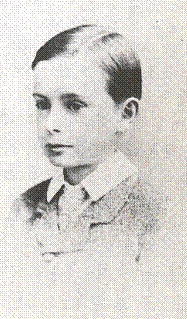 Hector in 1881 |
The Munro family and Benjamin Manning |
|
After
Hector's father came back, he and the children moved
to other parts of North Devon, including Heanton and
Westward Ho. Later Hector moved to London where he
became well known for his historical and political
writings. But he was also always known especially
for his love of nature, and the countryside and wild
places.
This is especially evident in his short novel, "When William Came." He describes a "land where the mill race flowed cool and silent through water weeds and dark tunneled sluices, and made soft music with the wooden mill wheel." The novel isn't about Devon, but those lines could be a description of the Bradiford Valley, as it was when he was a boy, with its sluices and its leats and its six Mills. Hector Hugh Munro was also a keen naturalist and his collection of bird's eggs is said to have been given to either Bideford or Barnstaple Museum. As of yet it has not been discovered, but could be somewhere in the attics of one of these buildings. We have also learned that other items connected with the Hibbert family and otter hunting are in the possession of the Museum in Barnstaple. More will be added soon about the six (or even seven, if including one in the Manning's Pit fields) Mills of Bradiford Valley and their influence on both F R Lee, who loved to paint Mills, and Saki. |
| Saki lost
his life at the age of 41, when he was killed by a
sniper in the First World War, but his stories remain
popular today, and there is world wide interest in his
work. The photograph on the left shows him in his Army Uniform of the 2nd (or 22nd?) Royal Fusiliers. He enlisted first in the 2nd King Edwards Horse but he wasn't strong enough to cope with life in the calvary, so he exchanged to the Royal Fusiliers. Incidentally, Colonel Hibbert had also been in the Royal Fusiliers. From the story in the Macclesfield Express, linked to above, Colonel Hibbert appears to have cared about the ordinary men who served under him, and included praise of a cook, Bradley, a local man, in his speech. That sympathy for ordinary men may also have been something that Hector modelled himself on later. |
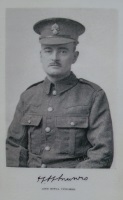 |
| One more thought in regard to the Munro's
neighbours at Broadgate House - how much would
visits to that house, with its works of Art, even
possibly a Gainsborough (we believe, still checking!)
as well as Lee's paintings, have stimulated the young
Saki's imagination? F R Lee was away on his yacht
during much of the 1870s, and died in 1879, but
whether Hector met Lee or not, he would have heard all
about him, and he certainly could have been another
souce of inspiration. Art and artists certainly feature in some of Saki's stories, for example The East Wing, which reads as if it could be a description of Broadgate House (with the painting of Eva being sent to Exeter for cleaning.) Another story that brings Lee to mind is "The Stalled Ox", with its references to the Royal Academy, as well as to artists who paint cattle (Thomas Sidney Cooper who collaborated with Lee was famous for his cattle and sheep paintings.) Just because Ethel does not mention anything about their glamorous and interesting neighbours doesn't mean that they were not of interest and influence to Hector. Once we started looking for links between Hector's life in Pilton and his stories, we have kept on finding them, and here are two more: In The Toys of Peace, the boys have a great uncle who fought in the battle of Inkerman.... just like Hugh Hibbert. And in "The Watched Pot," a Colonel arrives at a West Country Manor who wants to nominate a candidate for a forthcoming election (see our notes above about the 1880 By Election). Of course, this may all be coincidence - we are not historians or scholars - but it makes a new and interesting way to look at the stories.... just type in "sword" and Saki for example, and you come up with another story that could have been triggered by some childhood memory. We haven't investigated butchers or pigs yet... Interesting Links |
Saki: WikipediaVideos and podcastsProfessor Tim Connell's 2006 LectureStephen Fry and Shredni Vashtar Saki's birds The Open Door The Lull Improper Stories The Double Life of Saki - BBC4 film, not accessible on iplayer at the moment Saki TV Mini Series 1962 |
Books and Articles:The Unbearable SakiSandie Byrne The Toys of Peace Rothwell Reynolds The Square Egg, and other sketches with three plays, by Saki (H.H. Munro) with a biography by his sister. Blowing cigarette smoke at Greenfly Saki, A Life of Hector Hugh Munro by A.J Langguth Jeffrey Archer on Short Story Writers, especially Saki Christopher Hitchens Review of The Unbearable Saki |